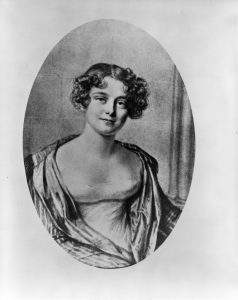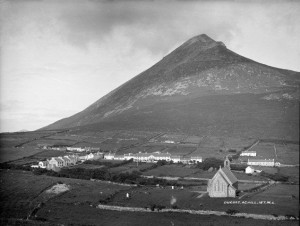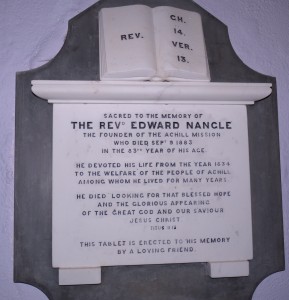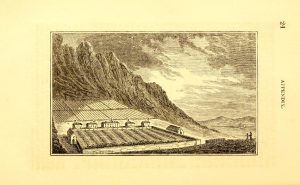‘Like another Luther’: Lady Jane Franklin’s visit to Achill Island recalled

Patricia Byrne on Lady Jane Franklin’s visit to Achill and the controversial Protestant mission there. See also her article on Edward Nangle’s Protestant mission and the role of women missionaries on Achill.
Passion for Travel
Travel was Jane Franklin’s abiding passion. Her biographer, Alison Alexander, has described her as probably ‘the most travelled woman of her time’ who made long, adventurous trips to every continent except Antarctica, managing in the process to negotiate the restrictions placed on women of the period.[1]
Following her marriage to the explorer, Sir John Franklin, and his subsequent disappearance on an Arctic expedition, she became one of the most famous Victorian women of her generation.
Alongside her fierce appetite for travel, Jane had a compelling need to write things down and record every experience with acute powers of observation. She did not publish any books but left behind voluminous notebooks, journals and diaries[2].
Jane Franklin was probably the most travelled woman of her time
She had a reticence about her writings being made public and wrote in an early journal: ‘This book is meant for my own reading only, though I would not absolutely deny my sisters from looking into it should it fall into their hands when they can no longer ask my permission. I may say the same of all my private journal books.’[3]
Jane was born in London in 1875, the second of there daughters of silk-weaver John Griffin and his wife who died in childbirth when Jane was just four years old. Her only brother died at fourteen of lung disease. From a young age she was taking long summer trips through Britain, whetting her appetite for exploration and adventure, and by 1815 they were on an extensive two-year tour of Europe.
The turning point of Jane’s life was her 1828 marriage to John Franklin, just months before his knighthood in recognition of his Artic explorations. From this time onwards, Lady Franklin combined her thirst for travel and adventure with another consuming goal: to advance the career and reputation of her explorer husband.
Innuendos of a romantic affair
When Jane arrived in Ireland in 1835, she was seven years into the marriage and restless. In contrast to her middle-aged, stout, balding husband, she was slim, graceful and elegant, her warm face framed by soft curly hair, and full of vibrant energy even if in her early forties. In the previous three years she and John had spent much time apart while he served in the Mediterranean and she travelled extensively in the region.
Controversially, the previous year she had spent several months travelling alone on the Nile with a Prussian missionary, Johann Lieder, leading to innuendos of a romantic affair. When she returned to England in October 1834, she had not seen John for over a year, and was ill on and off for months, perhaps pining for her exotic Nile companion. A trip to Ireland may have been a welcome diversion.
‘Like another Luther is Mr Nangle in Achill’

It was an extraordinary sight that Jane Franklin encountered on the slopes of Slievemore on the northern coast of Achill Island: five two-storey slated houses – something never seen on the island before; ten acres of reclaimed land producing potatoes and vegetables; eight cabins under construction to house converts in what was the infant Achill Mission settlement.
Jane got to see the Mission development up close in its earliest days, just a year after Edward Nangle – together with his wife Eliza, sister-in-law Grace Warner, and three small daughters – settled at Dugort to spearhead the proselytising mission.[4] The Achill Mission grow into a notorious and controversial project.
‘I have seen missionaries in many countries but never one so pure and high-minded as Mr Nangle’.
Before reaching Achill, the Franklins had received a favourable report about the work of Edward Nangle’s mission from an unlikely source: Father Lyons, Roman Catholic Dean of Killala, County Mayo, told them: ’He is an excellent man and he is doing a great deal of good to the poor people of Achill.’[5] The difficult journey to the island would likely have excited the adventurous Jane: ‘At Ballycroy we were detained four days by a hurricane, living all this time in the coastguard watch-house and the cottage of the chief boatman.
At the end of this time, Mr Nugent took us over in his galley to the Bull’s Mouth Station…’ . [6] Despite her reticence about allowing her writings to be made public, she reluctantly agreed to allow her friend, John Barrow – clerk at the Admiralty – to include her account as an Appendix to his book, A tour round Ireland through the sea-coast counties in the autumn of 1835. Barrow had toured Ireland extensively that autumn but did not visit Achill. Jane had a strict stipulation, however: ‘I cannot comply with your wish to mention my name.’

A low-church, ‘no-frills Protestant’, Jane was instinctively supportive of Edward Nangle’s daring Achill Mission project and what she perceived as ‘the resistance it opposes to a spiritual tyranny’ of the Catholic Church.
In her view, Catholicism and its priests were a powerful barrier to the improvement of the conditions of the Irish. Edward Nangle appeared to her an awesome figure: ‘very tall and thin, pale and dark with finely-formed features’, mild and pensive but with an extraordinary fire in his eyes. ‘I have seen many missionaries in many countries, but never any one so devoted, so pure and high-minded as Mr Nangle.’ [7]
The visitors dined on potatoes and several vegetables from the kitchen garden at the Nangle table, observing that the single decanter of wine disappeared quickly with the table cloth at the end of the meal. Jane could see what a harsh year it had been for Eliza Nangle. Her first son – the child she had carried through a difficult Achill winter – had died two days after birth in April and Edward had buried the infant with his own hands in the small enclosed cemetery behind their home on the mountain slopes.
How did Achill explode with sectarian rage?
Jane Franklin must have felt the fierce tension in the island air for the visitors arrived just days after the Dr John MacHale, Archbishop of Tuam and a fierce adversary of Edward Nangle, paid a provocative three-day visit to the island. Robed in splendid episcopal robes, he officiated at a high mass in nearby Dookinella, trenchantly denounced the Achill Mission and forbade the people to have any interaction with the missionaries. Soon after, the Connaught Telegraph excitedly predicted that ‘in six months more, within the tenantless walls of the colony, will be heard only the shrill whistle of the whirl-wind, or the night-screech of the owl’. [8]
How could Achill have exploded with such sectarian rage so soon after the establishment of the Achill Mission colony? Within months of Edward Nangle arriving on the island, four Mission schools had been established at Slievemore, Dugort, Cashel and Keel. Education, to Edward Nangle was the key to conversion. It would open the scriptures to an illiterate peasantry steeped in Catholic superstition. It was the schools which gave rise to the fierce reaction from Dr MacHale and his clergy. The schools became the battle ground.
An education scheme that has failed in its object

Jane Franklin believed in personal improvement and in the power of education. Four years earlier, the Stanley Letter had authorised the establishment in Ireland of a non-denominational system of national education, with official financial support, that would be open and acceptable to the main religious denominations in Ireland.[9]
Both Edward Nangle and John MacHale initially vociferously opposed the national system, arguing that secular and religious education were inseparable. However, once several Achill Mission schools were established, the pragmatic MacHale saw an opportunity to secure national education funding to establish opposing island schools under the influence of the local clergy.
‘A a mouse gnawing the sacrament of the eucharist’.
Jane was unimpressed. It appeared, she wrote, perverse and illiberal that a scheme from which so much had been expected, ‘had failed in its object’, and appeared to have ‘widened the separation between the Catholic and Protestant population’. Was it for such entities as the MacHale schools in Achill that the scheme was established?
There was a danger, she warned, that the national scheme was being subverted to grow the ascendancy of the Catholic Church in Ireland. She drew on Edward Nangle’s statement to the House of Lord’s Select Committee for an account of the backlash against the Achill Mission schools over the previous winter and spring.[10]
When Edward Nangle published the proceedings of the Select Committee in relation to Achill, he penned an Introduction which made clear his view as to the central importance of a particular type of education to the Achill Mission’s work: ‘We say, let education – Scriptural Education – go forward. Let a determined and sustained protest be kept up against the National System which … permits the priest to deprive the youth of Ireland of the only means of their enlightenment.’
Writing over three decades later he was still adamant in his negative assessment of the National Board and its role as one of the agencies ‘whose influence was employed to crush the Achill Mission in its infancy’.[11]
The Select Committee heard other evidence which indicated the depth of sectarian bitterness raging in Achill. The island parish priest, Father Connolly, complained that the Achill Mission preachers had gone about the island bribing the people with clothes and money and exhibiting pictures ‘representing a mouse gnawing the sacrament of the Eucharist’. Edward Nangle’s own controversial statements concerning the Catholic worship of the Eucharist caused Jane Franklin to express her reservations about an overzealousness in the Mission’s approach.
She observed Edward Nangle preaching twice a day, railing against Popery and its priests, and holding up to ridicule the doctrine of the wafer: ‘the converting of a bit of paste, boiled in their own saucepan, and clipped with a pair of scissors’ into their Creator. She reasoned with Edward Nangle about the propriety of the approach of ridiculing objects and doctrines sacred to the people: ‘The mysteries of religion are not fit or fair subjects for derision.’
Jane Franklin was between two minds. On the one hand, she saw the potential of the Achill Mission to improve the lot of the island people and break what she saw as the tyranny of the Catholic Church. On the other hand, she feared that Nangle’s fearlessness and singlemindedness of character were, perhaps, proving injurious to his cause. She regretted that ‘any weapon sharper than the voice of persuasive reasoning, and any language less tender than the daily prayer’ should be used by the missionaries. Her reservations would be echoed by other Achill visitors and commentators in subsequent years, particularly in the following decade when famine descended on the country.
One of the best known Victorian Women of her day
Jane was determined to explore the island before she departed Achill for she was used to exploring, hiking, observing and, always, note taking. She took to the mountains on horseback, crossing the width of Slievemore behind the Achill Mission settlement, and also traversing the magnificent Minaun on the island’s south coast. While disappointed not to find an Achill amethyst stone worth taking away, she appreciated the superior quality of Achill mutton grazed on Atlantic-splashed heather.
She observed seals basking on exposed rocks at Achill Sound, then sliding into the water ‘like the crocodile of the Nile’.
While playing down her knowledge of the island plants, she nonetheless noted ’the miniature fern, the abundant thrift and London-pride, and the pretty little tormentilla, of which the peasants made a yellow dye for their shoe-skins’. She spied an eagle, watched foxes, saw rabbits swarm on Dugort sand dunes and fowl in abundance on Slievemore’s slopes. She observed seals basking on exposed rocks at Achill Sound, then sliding into the water ‘like the crocodile of the Nile’.
Within a year of their Irish visit, the Franklins boarded the ship Fairlie with a party of 23 en route to Tasmania, Van Dieman’s Land, where Sir John took up the post of lieutenant-general and where Jane Franklin swept energitically through the colony. She toured the island and took a proactive interest in promoting the social and cultural life of the young settlement. Six years later, at the end of the posting, Sir John obtained command of a naval expedition to find the Northwest Passage. When he failed to return, Jane embarked on a single-minded endeavour to locate him and to defend his reputation, becoming one of the best known Victorian women of her day.
Once she succeeded in her ambition to make her husband a hero, Jane Franklin returned to travel and adventure, accompanied by her niece and secretary-companion, Sophia Cracroft. They travelled extensively in North America, in Japan and – when Jane was almost eighty – in India and Alaska, driven by Jane’s desire to see all parts of the habitable globe. A fortnight after her death in 1875, a monument to her husband was unveiled in Westminster Abbey with the added inscription, ‘erected by Jane, his widow, who, after long waiting, and sending many in search of him, herself departed, to seek and to find him in the realms of light’.[12]
Jane Franklin, hugely energetic traveller, explorer, writer, and visitor to Achill Island, was born 225 years ago on 4 December, 1791 and died 18 July 1875.
Bio
Patricia Byrne is a Limerick writer. Her narrative nonfiction book The Veiled Woman of Achill – Island Outrage & A Playboy Drama is published by The Collins Press and deals with the 1894 Valley House atrocity on Achill Island. She is currently working on a book about the Achill Mission.
References
[1] Alison Alexander, The Ambitions of Jane Franklin. pviii.
[2] Most of Jane Franklin’s surviving papers are held at the Scott Polar Research Institute, Cambridge.
[3] W F Rawnsley (ed.), The Life, Diaries and Correspondence of Jane Lady Franklin 1792-1875. p48.
[4] For an overview of the Achill Mission, see Mealla Nī Ghiobūin, Dugort, Achill Island 1831-1861: The Rise and fall of a Missionary Community (Dublin, 2001).
[5] Henry Seddall, Edward Nangle, The Apostle of Achill – A Memoir and a History 1884. p76.
[6] John Barrow, A tour round Ireland through the sea-coast counties in the autumn of 1835. p 209.
[7] Ibid. p212.
[8] The Telegraph, 16 September 1835.
[9] For an overview of the Stanley scheme, see Garret Fitzgerald, Irish Primary Education in early nineteenth century (Dublin, 2013).
[10] Edward Nangle, The Origin, Progress and Difficulties of the Achill Mission: As Detailed in the minutes of evidence taken before the select committee of the House of Lords appointed to enquire into the progress and operation of the new plan of education in Ireland, and to report thereupon to the House.
[11] Achill Missionary Herald, January 1865.
[12] Alison Alexander, The Ambitions of Jane Franklin. p252.